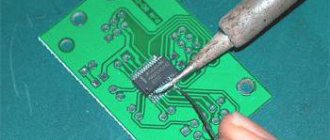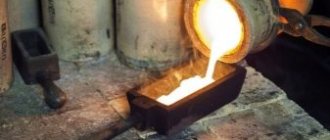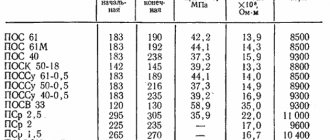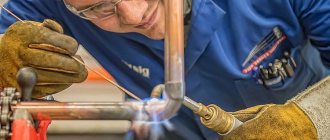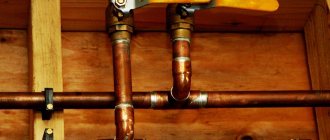Taps, hardware, pipes, decorative interior items and many other products are made from brass. This material is obtained by fusing copper, zinc (in different proportions) and various additives.
Soldering brass ensures a reliable and high-quality connection of parts. Soldering involves the use of a special tool in the form of a gas torch, as well as solder made from a mixture of tin and lead. In some cases, tin alone is used to make brass solder.
The essence of technology and its features
First of all, you need to familiarize yourself with the features of the soldering procedure.
This technology, as a method of creating permanent connections, is not as popular as welding, since the strength of soldering is somewhat lower. The formation of a weld occurs when a filler material called solder melts. After crystallization, the frozen composition reliably connects the workpieces.
A distinctive feature of soldering is the approach of impact on the working surface . When choosing solder, the main indicator is the melting temperature, which should be lower than that of the base metal. It does not change its state of aggregation, the properties remain unchanged. This allows you to connect workpieces with heterogeneous composition.
This is the difference between welding and soldering. When carrying out work, the weld pool includes the base metal and filler material. Together they form a seam, which invariably affects the quality of the metal that has been exposed to temperature. It is not without reason that when building a strip foundation, the frame is secured using wire rather than welding. Soldering does not affect the parameters of the base metal, which distinguishes it favorably from other joining technologies.
Let us highlight the main features of soldering:
- solder is used as a filler material;
- the products being connected do not melt;
- materials do not interact with each other;
- Suitable for connecting miniature elements.
The method is widely in demand in the field of high technology , due to the low temperature effect on the surface, which is the main indicator for temperature-sensitive components of boards and electronic circuits. Requirements for the quality of work are set out in GOST 17325-79.
Areas of use
The possibility of soldering with brass ensures a reliable connection of metal products, which determines the limits of application of this technology.
It would be impossible to do without this method of joining parts when producing products in such industries as:
- electronic manufacturing;
- assembly of refrigeration and heat exchange equipment (in this case, brass solder is used when soldering thin copper tubes);
- production of special cutting tools (cutters and attachments for them).
In the electronics industry, brass solders can be used to solder components of complex circuits and connect them to metal conductors.
In addition, brass solders are widely used when it is necessary to join metal workpieces of different thicknesses, as well as when carrying out tinning operations, which ensure the creation of a reliable protective coating on the metal surface.
Types of brass
There are two types of brass, differing in chemical composition:
- Double. As the name suggests, the alloy consists of two elements - zinc and copper in varying proportions. Moreover, zinc plays the role of an alloying element. According to technical requirements, such compositions have special markings indicating the type of alloy and the percentage of elements. For example, L 63 is a two-component composition, with a copper mass fraction of 63%. The zinc content does not exceed 37%.
- Multicomponent . Special formulations containing many impurities, the composition of which depends on the application. It is very difficult to select the optimal brass solder for such alloys, especially without knowing the exact ratio of the chemical elements in the composition.
Multicomponent alloys may include the following metals: aluminum, nickel, tin, manganese and others. Such compositions are often named by the name of the element with the highest content, for example, “aluminum brass”.
Soldering of non-ferrous metals
Products made of non-ferrous metals require precise fitting. That is why they are often soldered rather than boiled. Let's study certain types of non-ferrous metals and their bonding using soldering.
Always secure both workpieces using a vice, clamps or other fasteners. Especially if you are working with large parts. Vibrations or shifts during soldering can warp the seam and the solder can drip. This will make the joint brittle and, over time, cracks or fistulas may form on it.
Soldering copper
Copper is a fairly common metal in everyday life. Water pipes, electrical cables, electronic components - they are all partially or completely made of copper.
There are mainly two methods for soldering copper:
- High temperature (working temperature about 600 ˚С);
- Low temperature (working temperature up to 450 ˚C).
In this article, we are considering soldering at home, so we will take low-temperature technology.
To solder copper you will need:
- Solder. It is mainly made from alloys of tin (95-97%) with copper, antimony, bismuth, silver, and selenium. Silver-containing solders have the best properties. Three-component types, which include tin, copper and silver, are also widely used. The use of tin-lead solders in production is limited due to the harmfulness of lead. At home, you should also protect your lungs from lead fumes. Use an active hood.
- Flux for soldering copper (activated, acidic, non-acidic, anti-corrosion).
- Gas-burner.
Large industries and factories often use solder paste. Most often it contains: flux, small particles of solder and special additives.
Let's look at the step-by-step technology for soldering two copper elements:
- Flux is applied to both parts. They cover the joint and the area where solder will be applied.
- Solder is placed at the joint. This can be tin wire or a special paste.
- The resulting compound is heated using a gas burner. Solder is distributed over the joint, as well as partially over the area near the solder.
- The resulting workpiece is left to cool. At this moment, you cannot twist or bend the resulting part. The joint must be completely cool before the solder can fully harden.
- Remaining flux is removed using an abrasive brush.
Do not point an open flame directly at the solder. It should melt and fill the seam due to heating of the edges of the parts.
Soldering aluminum
Aluminum is a rather capricious material. Many experts believe that it is simply impossible to fasten two aluminum blanks at home, since the place of fastening must be heated to a temperature of about 600 ° C, and this risks burning out the aluminum sheet itself.
But this statement is not entirely true. You can solder two aluminum elements if you use a special flux and solder. Let's take a closer look at all the components that will be needed to work with aluminum:
- Solder. The best solders for working with aluminum are those containing: silicon, aluminum, copper, silver and zinc. These include domestic solder “34A” or its foreign analogue “Aluminium-13”.
- Flux. It is better if it contains ammonium fluoroborate with the addition of triethonalamine. Some people use regular borax.
- Soldering iron with a power of at least 100 W.
Solders with a high zinc content have better anti-corrosion properties.
Step-by-step guide to soldering aluminum blanks:
- Clean both workpieces from dirt and dust.
- Remove the oxide film using sandpaper. This operation is performed in order to reduce the oxide layer that instantly forms on the surface of the aluminum.
- Flux is applied to the joint.
- Solder is applied evenly and gradually, without subjecting the surface of aluminum workpieces to constant heating.
- The resulting joint is cleaned using a wire brush or fine sandpaper.
Soldering sheet metal
Ordinary tin is fastened quite simply. Metal without impurities or coating most often produces an even seam and does not change under the influence of high temperatures. To solder sheet metal you will need:
- Solder. Solders based on tin and antimony are mainly used. These include POS-40 or POS-30. In some cases, POS-90 is used, which contains lead.
- Flux. Both hydrochloric acid and ordinary rosin will do. Fresh oxide film on tin can be removed very easily.
- Soldering iron with a power of at least 40 W.
Fluxes
A competent choice of flux is the key to a quality connection. It cleans the surface of traces of oil, dirt and oxides and prepares it for soldering. Due to the characteristics of the material in question, it is not advisable to use neutral compounds based on alcohol and rosin. Experts recommend using active flux to effectively remove the oxide film.
An important factor is the chemical composition of the alloy . For the classic two-component material L 63, it is enough to use a solution of zinc chloride in boric acid. For multi-component alloys, it is better to purchase a universal flux for working with brass - PV 209 and PV 209X. When choosing a ready-made composition, you should carefully study the instructions with recommendations for use.
Electric arc
For standard electric arc welding, it is best to use electrodes made of brass wire (and the share of zinc in this wire should be 40%) with inclusions of aluminum, iron, lead, and manganese.
When the device is turned on, a constant electric current of direct polarity must pass through these electrodes. In this case, welding is carried out with a short arc from a position from below.
The arc must be maintained at a current of 250 amperes for electrodes 5 mm long. In this case, the speed of laying the seam can reach 30 cm per minute.
At the end of the main operation, the weld should be additionally forged and heated to a temperature in the range from 600 to 650 °C. This will give the connection greater strength.
Solder
Beginning craftsmen do not know which brass solder to choose to achieve the best results.
Let's look at the main brands:
- For soldering brass and copper, experts recommend using solders of the copper-zinc group. When choosing, you should pay attention to the melting point. For example, for PMC-48 it is 880 Cº.
- Copper-phosphorus solders of the MF group are distinguished by their affordable price. Performance characteristics are slightly lower than those of compositions with the addition of silver.
- The PSR group of silver solders belongs to the hard grades. The resulting connection is highly resistant to mechanical and vibration loads.
When soldering steel with brass, the L-63 alloy is used, which has proven itself best . Release form: brass wire for soldering. It is used exclusively for working with hard-melting materials.
Brass solders with flux deserve attention. Their cost is higher than that of classic compositions, but the price is compensated by ease of use and a reduction in the number of defects in work.
DIY cooking
Many craftsmen prefer to prepare solder with their own hands at home. A mixture of two parts silver and one part copper has proven to work best .
After taking measurements, the metal is melted in a crucible and by stirring it is achieved to obtain a homogeneous mass. Cooling takes place in cold water.
The finished solder is given the desired shape, after which it is cleaned using a large file.
The optimal dimensions of the crucible are 20x20. It can be based on graphite carbons from contact elements.
Soldering iron
The main difficulty in working with brass, as opposed to soldering other non-ferrous metals with a torch or soldering iron, is the oxide film that forms during the evaporation of zinc after heating the brass.
alloy using a soldering iron, you need a high-quality device with a power of at least 1000 W. This requirement is due to the high melting point of brass and the solders used. The exception is copper and brass alloys, whose melting point is much lower.
The best choice is a soldering station with a function for adjusting temperature parameters. The use of such equipment makes it easy to select optimal operating parameters without the risk of surface overheating.
Preparation
The thermal conductivity of the copper-zinc alloy is much lower than that of the constituent elements, so there is no need to preheat the workpieces for welding. If the thickness of the material is impressive, then you can limit yourself to local heating.
The joints of the workpieces are processed in several ways, based on the thickness of the metal sheet. With a thickness of up to 1.5 mm, a flange is made along the edge. The height of the side should reach twice the thickness of the sheet. When the workpiece thickness is from 1.5 mm to 6 mm, the surfaces are not processed, and when welding, a gap of 1-2 mm is provided between the edges. The use of shims requires increasing the gap to 3 mm. Edges of greater thickness are cut at an angle of 30-45°C degrees.
In order to carry out high-quality welding of any alloy, it is necessary to take into account the properties of each component element. Welding brass is similar to welding copper, but the presence of zinc makes some adjustments to the algorithm. It is customary to distinguish three methods of welding brass:
- arc welding;
- argon arc welding;
- gas (gas-flame) welding.
Using the burner
A gas torch can be used to solder brass . Special requirements are placed on the placement of the workpiece - it must be placed on a surface made of heat-resistant material.
The preparatory stage does not differ from a similar procedure before soldering with an electric soldering iron.
The process begins with gradual heating of the surface in order to increase the wetting properties of the solder. After this, the workpiece is heated to operating parameters, the achievement of which is characterized by the appearance of a characteristic red tint on the surface.
The use of flammable gas does not have any particular advantages over electrical power sources.
Types of gas appliances
There is a fairly wide range of gas soldering devices, which are logically divided into types depending on the operating temperature.
According to this criterion, devices can be household, where the heating rate reaches a maximum of 1500°C, and professional - with an operating temperature of over 1500°C.
The type of connection also varies.
The fuel container can be refillable or disposable.
As for fuel, depending on the power source, the burners use propane, MAPP gas, oxygen gas, multifuel. The latter option is not used for soldering copper pipes, but is very convenient in everyday life, especially when hiking. Although experts consider such burners less reliable.
Below we will consider in more detail each of the mentioned types of gas equipment using different types of fuel.
Type #1 – propane burners
Propane tools ensure efficient performance of work aimed at heating, melting, and soldering metals of relatively small mass. The thickness of the working metal is usually 2-9 mm.
Typically, the base of a propane torch is made of brass. The nozzle structure is made of high temperature metal, usually stainless steel.
For the most part, these are devices with manual flame adjustment through a control “reducer” - a regulator located on the pipe, which goes to the nozzle. Propane burners produce a flame temperature of 1300°C.
Type #2 – devices for MAPP gas
Gas burners, designed to power the MAPP with gas, are successfully used for various purposes related to the processing of metals, in particular copper.
Stages of work
Step-by-step instructions for the process of soldering brass at home are as follows:
- Cleaning and degreasing the joint.
- Surface treatment with flux.
- After completing the preparatory procedures, add solder, crushed to the state of chips, into the heating zone.
- We begin gradual heating of the surface. It is important that the flame constantly moves to avoid overheating.
- After forming the seam, we stop processing the workpiece and wait for it to cool under natural conditions.
- Wash off the remaining flux.
The quality characteristics of a weld depend on the correct choice of consumables and filler materials, as well as compliance with the requirements for the technological process.
Differences between metal soldering and welding
There are two main methods of joining two metals: welding and soldering. In the first case, the elements are held together by melting the edge of the metal. This can be either heating or bonding using pressure. In the case of soldering, the workpieces are fastened together using filler material - solder.
In some cases, soldering is a more gentle and economical way of joining workpieces. Soldering also has a number of advantages:
- Both parts do not heat up to the melting point. In this way, it is possible to preserve their physical and chemical properties.
- The workpieces do not require thorough cleaning and processing, as is required when welding.
- Soldering equipment costs much less than welding machines.
- Possibility of manufacturing complex units and structures.
- The strength of the resulting joint. The parts do not bend or deform after soldering.
